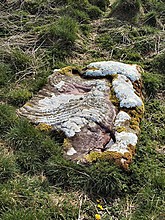|
|
|
|
Kenward StoneCarving
|
|
|
|
Images (click to view fullsize) |
|






|
Fieldnotes |
|
|
Ken Watts in "Exploring Historic Wiltshire" records that a 19th century farm labourer recalled moving the stone from Kinwardstone Farm at Burbage 5 miles away. However it seems odd to move a large stone this distance to such a remote spot when field clearances normally involved moving sarsens to the edge of a field or breaking them up. Kinwardstone itself is the name of the local medieval hundred. The stone is highly unusual and only a geologist can determine whether the markings are natural or man made. Some sarsens carry striations caused by glacial movement and the lines look less clearly man made than the grooves for example on the Polissoir Stone at Avebury. The stone lies at the edge of a pit (which may relate to the building of the adjacent Roman road along Chute Causeway). There are three sarsens in the Churchyard at nearly Tangley and remnants of a sarsen chambered tomb at Tidcombe longbarrow a mile away. |
Posted by cc 12th January 2005ce Edited 12th January 2005ce |
|
Managed to find this stone at last having looked in the wrong place before. My thanks to Prof. Caroline Tisdall of the Conholt Park Estate for pointing me in the right direction. What a very odd stone. The markings are shallower than I expected but quite obvious. The most prominent features are the 5 or more grooves which describe a very regular arc. Tracing it out, my fingers fitted perfectly. From the top of the arc the grooves split off at an angle and are straight but less well defined. There are other ill-defined marks but I didn't want to remove the moss which was obscuring them. The "frame" at top of the stone is also a curious feature but has a "natural" feel to it. What is one to make of this stone? The geologists who looked at it in the 1920s rather sniffily dismissed the marks as natural but I'm not so sure. I've seen a fair number of sarsens but this is the first time that I've come across anything that looked like this. When I was there (21.11.04) the light was not the best for seeing the marks as there was thick fog. It needs a good photographer with lights to bring out the details. |
 Posted by jimit
Posted by jimit21st November 2004ce |
|
I have provisionally posted this as a carved stone although the last time it was really looked at, in the 1920s, the general concensus was that the marks were natural. However I have not seen marks in Sarsen that look quite like these. People with more experience of rock art than I may have other opinions. If the marks are truly man-made they are rare in this part of the country. The picture quality is explained in the caption. Access Park on verge at T junction, cross road to field gate and the stone is in the hollow to your right about 50M away. Tussocky grass. (The hollow in which it lies is one of the quarry pits used by the Romans to construct the Chute Causeway, a diversion on the Winchester-Cirencester road to avoid the steep valley to the North) |
 Posted by jimit
Posted by jimit25th September 2004ce Edited 21st November 2004ce |
Folklore |
|
|
Dr J.P. Williams Freeman was told by a "native" in 1915 that the carvings(?) represented a man's entrails and the holes were made so the stone could be moved with ropes "but the horses fell down dead". During an excavation in 1924 by H. St. George Grey, a shepherd said that the stone was called the "Devil's Waistcoat" In 1883 the Rev. Canon J.E. Jackson F.S.A said "It is traditionally called the stone of one Kinward, some ancient magnate who held his Hundred court here in the open air.....". Information from the Wilts Arch Mag Vol 43 1925-27. With thanks to Martyn Henderson of the Wilts and Swindon Record Office. |
 Posted by jimit
Posted by jimit25th September 2004ce Edited 25th September 2004ce |
Miscellaneous |
|
Mention of a twin stone?Kinwardstone -- This, the largest hundred in Wilts, seems to have taken its name from a block of sarsen stone, which remained in situ till about 1835-40, when it was destroyed, partly by accident, partly on purpose. It stood by the south side of the Roman causeway, a little west of Conholt Park, in the angle formed by the turn of Dummer Lane southwards to Chute.Page 87 in 'Wiltshire Notes and Queries', v1 (1893-1895). |
 Posted by Rhiannon
Posted by Rhiannon14th March 2011ce |
|
Although the Kenward stone is considered natural there is another story attributed to it that may give it a prehistoric link. John Chandler has written about it in this Wiltshire Council link.... http://www.wiltshire.gov.uk/community/getconcise.php?id=60 which states that the stone had been removed from a field in which other stones lay... "about 1890, he reported, he had been told by two of Chute's oldest inhabitants that the stone had been moved there from a field where there were other big stones, some of which had been buried out of the way. But nobody by 1924 could remember where, and so part at least of the pseudo-Kenward stone's mystery remains." |
 Posted by moss
Posted by moss11th March 2010ce |

